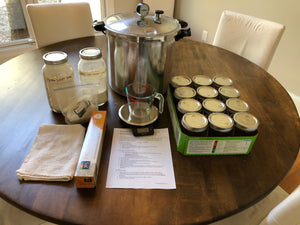The Starter Made Easy (Pressure Cooking Your Starter Wort Ahead Of Time)
We all know that starters are one of the big keys to making top-notch beer, but it's a pain. You have to make the starter wort when you need it, wait for it to cool, worry about sanitation and then pitch it. That smells a lot like planning, something home brewers generally try to avoid!
My answer is to can your wort in mason jars. The process is almost identical to the one that you or your family may have used to preserve peaches, tomatoes, pickles, etc. The normal preservation method is hot water bath canning, but since wort is a low acid food you must use the more intense method of pressure canning (per the FDA). So to safely can your wort, you'll need DME (or wort), some yeast nutrient, a pressure cooker and a case or two of Quart (or pint) Mason Jars. Make sure the jars are for canning and not drinking. Manufacturers like Bells and Kerr are well known and reliable.
Do you remember your mom's pressure cooker? It was the magical kettle that cut the cooking time on everything and guaranteed that your food would be moist. Unfortunately, it also guaranteed that your food would be bland and tasteless. But it works in the same way that a lab autoclave does. Water at atmospheric pressure boils at 212F and won't go any higher. If you increase the pressure you'll increase the maximum temperature. A pressure cooker generally will operate at 15 p.s.i. causing water to boil at 250F. This is the magic point for sterility. Exposing a substance to 250F for 15 minutes will kill all the common spoilage agents brewers worry about.
Sterility is important in any of our long-term storage applications for starter wort. A single organism trapped in a jar of wort can replicate and eventually cause a nicely sealed jar to explode or turn the wort sour and useless.
Once you have the equipment, making the starters themselves is a breeze. Start by filling your pressure cooker with the prescribed amount of water, usually just enough to come above the canning rack by an inch, and start heating. Using clean jars and lids, prepare your wort. I use the recipe below. Simply measure the DME into a jar, add a pinch of nutrient, and a hop pellet (if you're inclined). Add hot water then seal, hand tight, with a lid and ring. Shake to dissolve the DME and then place in your preheating cooker. Once the cooker is full, close the lid down on the cooker, but DO NOT seal the cooker yet. Once you see steam flowing out of the cooker vent, place the pressure weight on and wait for the cooker to come up to pressure. Turn the heat back to hold 15 p.s.i. and start counting your 15 minutes. After 15 minutes, turn off the heat and let the cooker cool naturally. Express cooling by pressure relief or running cold water over the pot isn't recommend as it may interfere with the sealing of the jars. Remove the jars (Carefully! They're HOT!)and wait for them to cool, remove the rings, label and store.
You now have a jar of starter wort that's ready to go whenever you need it! To use, pop the lid on the jar and pour into your starter vessel. At this point that's all you need to make or grow a starter!
When I do this (about every 4-6 months) I can produce 9 quarts of starter at a time with my 22 QT Presto Pressure Canner that I got from an Ace Hardware Outlet in New Jersey. With a total of 3 runs (each run is about an hour) I can take care of my starter needs during a busy brewing cycle for more than 3 months. So with about 5 hours of work, I can do starters with a minimum of fuss. By changing my starter recipe slightly you can even prepare wort agar plates for streaking and ranching your yeast too. If anyone is interested in learning to do starters this way, feel free to ask me.
Be careful! Pressure cookers can be dangerous pieces of equipment that if mishandled can lead to serious consequences. For once in your life, make sure to read the manufacturer's instructions to understand how to operate your model of cooker. The second the seals begin to harden replace them. If anything is wrong with the cooker, don't precede. Don't force cool the cooker or vent the pressure because the jars might explode.
We like to have all of our members make it through their brewing endeavors intact! Well, unless you're Mick and we're talking about your malt mill.
Places to look for more information or parts:
Pressure Cookers:
EBay (www.ebay.com)
Ace Hardware (www.acehardwareoutlet.com)
Flea Markets
Pressure Canning:
FDA: http://vm.cfsan.fda.gov/~dms/a2z-c.html
OneCook.com: http://www.onecook.com/reference/canning.htm
Drew's Pressure Cooker Starter Recipe:
Yields 1 Quart. (Half DME for pints)
| 3.2 ounces (by weight) | Light DME |
| 1 pinch | Yeast Nutrient |
| 1 small | Hop Pellet. (Optional) |
| Water to fill. |
Weigh DME into jar and toss in the super food and hop pellet.
Fill with water until just ¾" below the top of the Mason jar. (Generally I go right to the line where the ring snugs into the jar)
Place a lid and ring onto the jar and hand-tighten until snug, but not overly tight.
Shake to mix.
Place with other jars into a pre-heated pressure cooker. Make sure jars are sitting on a canning rack or excess rings. Sitting the jars on the bottom may cause them to crack.
Close the lid onto the pressure cooker leaving the vent open.
Allow the cooker to steam out of the vent to purge air.
Close the vent and allow the cooker to rise to 15 p.s.i.
Maintain 15 p.s.i. for 15 minutes and allow to cool naturally.
Remove jars from the cooker and allow to cool thoroughly before using.
Drew's Starter Recipe w/o a Pressure Cooker:
Yields 1 Quart. (Half DME for pints)
| 3.2 ounces (by weight) | Light DME |
| 1 pinch | Yeast Nutrient |
| 1 small | Hop Pellet. (Optional) |
| Water to fill. |
Heat water in an open saucepan. (Make sure you have a tight lid for the pan)
Turn heat off and stir in DME, nutrient and hops. Stir to dissolve.
Boil for 15 minutes.
Just before finishing the boil tightly cover the pan for a few seconds and then kill the heat
Crash cool the starter in a water bath or the freezer.
(The next bit of work should be ideally done under a flame to create an updraft to prevent bacteria landing in the starter)
Transfer your starter wort to a clean and sanitized growler.
Flame the mouth of the growler and the lip of the yeast vial.
Pitch into the wort and close growler with a sanitized piece of alumimun foil.
Now shake the growler every time your eyes fall on it.
(The foil encourages air transfer and yields a healthier starter)
You can repeat this method to grow make more wort for increasing a starter for bigger batches or higher gravities
Either Pitch the whole growler of starter or:
Chill before brewing and decant most of the liquid off the slurry.
Optional Accessories:
Magnetic Stir Plate.
Stirred Starters will experience almost a 4x yeast yield over a hand mixed starter.
Pyrex Flask
Allows you to grow the culture in the same vessel as you made the Starter, skipping the transfer stage.
Oxygen
Just as important in a starter as a batch of beer.
Pressure Cooker & Mason Jars
Make your starters ahead of time and make starting a batch of beer more convenient than ever.


1 comment
Nice write up. I’m wondering what is the purpose of the hops in the starter though.
DJ